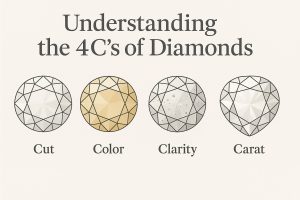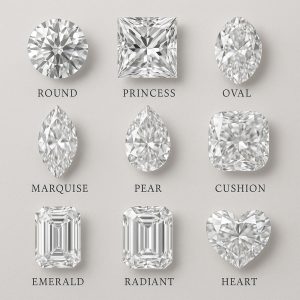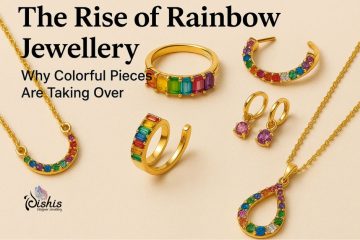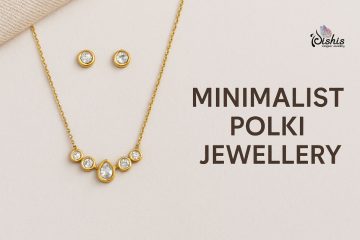Choosing an engagement ring is one of life’s most meaningful purchases. This special jewellery symbolises love and commitment, so finding the perfect ring deserves careful consideration and planning. The comprehensive guide will walk you through everything. You need to know about selecting an engagement ring to delight your partner and stand the test of time.
Understanding your partner’s style
The first step in choosing the perfect engagement ring is understanding the preference of your partner’s style preferences. This will help you ensure that the ring is according to his preference and taste.
Pay Attention to Existing Jewellery
Take a close look at the jewellery. Your partner is currently wearing it. Do they prefer yellow Gold, White Gold, Rose Gold, or platinum? Are there pieces? Typically modern and sleek, or vintage and ornate? Do they wear statement pieces or subtle things? The answers to all the questions will provide you with the inside of what they are looking for, and what their preference are.
Consider their style
Your partners, daily activities, and lifestyle reflect a lot about your choices. If they work with their hands or lead an active lifestyle, a lower profile setting or more durable design might be practical. For someone who works in a professional environment, a classic, elegant design might be more suitable.
Ask Friends and Family
Close friends or family members often have insights into your partner’s preferences. They might have heard your partner’s comment on rthe ing. They admire or know about their specific style. Just make sure this confidence can keep a secret if you are planning for a surprise proposal.
Pinterest Addict
Many people save images of rings on platforms like Pinterest or on Instagram, discreetly, checking these sources, my reveal specific styles, designs, designers, or settings that may catch their eye.
Setting Your Budget
Engagement rings come in a wide range of prices, from a few hundred dollars to several thousand or even millions. Setting a realistic budget before you start shopping helps narrow your options and prevents falling in love with a ring that’s beyond your means.
Traditional guidelines
Traditionally, the rule of thumb was to spend two or more months’ salary on the engagement ring. However, these guidelines originated from marketing campaigns and don’t necessarily reflect what’s reasonable for your financial situation.
Modern Approach To Budgeting
Today, many couples take a more practical approach, considering their current financial obligations, saving goals, and other upcoming expenses. Remember that the value of an engagement ring lies in its symbolism, not its price tag.
Hidden Cost To Consider?
When budgeting for an engagement, the factors that you need to check out is
- Insurance
- Regular Cleaning and Maintenance
- Potential Resizing
- Extended Warranties
- Taxes and Shipping
Understanding the 4C’s of Diamond

If you are considering a diamond engagement ring, familiarising yourself with the 4 C’s is important:
-
Cut
The cut refers to how well a diamond is shaped and faceted; no, we are not talking about its shape. A well-cut diamond reflects light beautifully, creating a more desirable look. Cut is often considered the most important of the 4Cs because it has a greater impact on the diamond’s brilliance. Cut grades typically range from excellent to poor, prioritising an excellent or very good cut will ensure your diamond has maximum brilliance and fire.
-
Color
Diamond colour is graded on the scale from D, which is colourless, to Z, which is light yellow or brown. Colourless diamonds are most valuable, but near colourless diamonds can look virtually colourless to an untrained eye, especially when set in yellow or rose Gold.
Most engagement rings fall in the G2J range, offering an excellent balance between quality and value. The colour difference between adjacent colours is subtle, so you can often save money by choosing a slightly lower colour without a noticeable difference in appearance.
-
Clarity
Clarity measures the presence of internal flaws and external blemishes in a diamond. The clarity scale ranges from flawless to included. Many enclosures are not visible without magnification, so you don’t necessarily need to invest in a flawless. Flawless diamond. Slightly included diamonds can be excellent value if the inclusions are not visible to the naked eye and position when they are hidden by the setting.
-
Carat
Carat refers to the weight of the diamond, and not its size. While larger diamonds are generally more expensive, carat weight should be considered alongside the other 3Cs. A smaller, high-quality diamond, maybe more beautiful and valuable than a larger diamond with poor colour, quality, and clarity. Consider choosing a diamond just below the popular carat weight to save money without a noticeable difference in appearance.
Exploring Different Diamond Shapes

Diamonds come in various shapes, each with its unique characteristics and appeal:
-
Round brilliant
The most popular and classic choice, round brilliant diamonds, offer maximum sparkle and versatility. They are timeless and work well in almost any setting.
-
Princess cut
This square or rectangular shape with pointed corners is the second most popular choice. Princess cut Offer, excellent brilliance, and a contemporary look.
-
Oval
Oval diamonds create the illusion of greater size and can make many fingers appear longer and similar. They are graceful, elegant alternatives to round diamonds.
-
Cushion Cut
With rounded corners and larger facets, cushion-cut diamonds have a romantic, vintage appeal and beautiful brilliance
-
Emerald Cut
Known for step, cut facets, and rectangular shape, the Emerald cut creates a hall of mirrors effect rather than a sparkle of brilliant cut. It has a sophisticated look.
-
Pear
This teardrop shape combines the best of round and Marquise cut, creating a unique and elegant club that can also make fingers appear, Leimer
Choosing the Right Metal
The metal you choose for your engagement ring, setting, affects both its appearance and durability.
-
Platinum
Platinum is hypoallergenic, naturally white, and extremely durable, making it an excellent choice for everyday wear. It is more expensive than gold, but requires less maintenance over time as it doesn’t tarnish or lose metal when scratched.
-
White Gold
White gold offers a similar appearance to platinum at a lower price point. It’s an alloy of gold and white metal, like nickel and palladium. They typically plated with extra witnesses and shine. Rhodium plating may need to be renewed every few years to maintain its bright appearance.
-
Yellow Gold
Traditional and classic, yellow gold never goes out of fashion. It is a timeless choice that complements warm skin tone beautifully. Pure gold that is 24K is too soft for jewellery, so engagement rings typically use 14 K or 18 K Gold, which contains other metals for strength
-
Rose Gold
With its romantic pink hue, rose gold has gained popularity in recent years. It is created by alloying gold with copper and silver, and its warm tone complements a wide range of skin tones.
Selecting the perfect engagement ring is a deeply personal journey that involves understanding your preferences and style, setting a realistic budget, and navigating various options in terms of diamond, gemstones, metals, and settings. By approaching this process thoughtfully, you will be able to find the perfect ring for your engagement. Remember that beyond all the technical specifications, the most important aspect of engagement is the commitment and love. It represents whether you choose a classic diamond Solitaire or a unique alternative gemstone. What matters most is that the ring feels right for your relationship and the person you love.



0 Comments